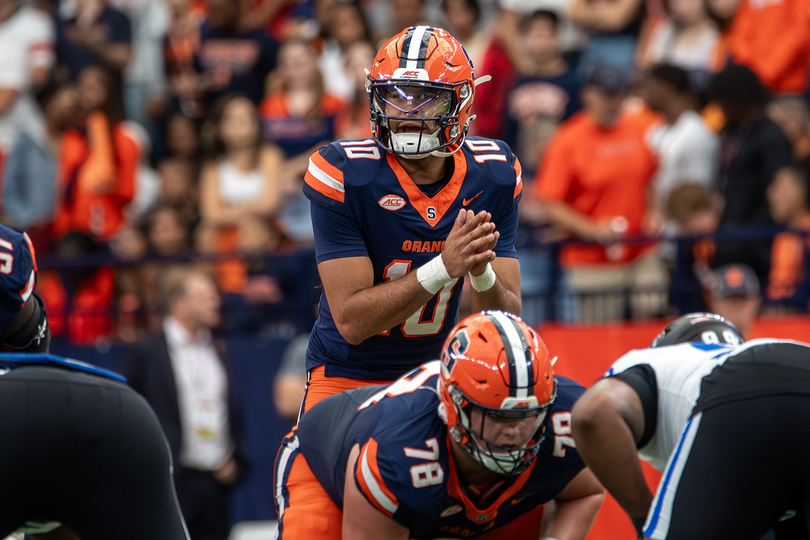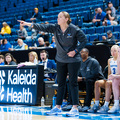Why is Rickie Collins struggling? PFF analyst says he ‘locks into’ his 1st read.

Rickie Collins has struggled to start his Syracuse career, tossing five interceptions. PFF analyst Dalton Wasserman analyzes how Collins can improve. Leonardo Eriman | Photo Editor
Get the latest Syracuse news delivered right to your inbox. Subscribe to our sports newsletter here.
Syracuse football is 0-2 while being outscored 69-21 since Rickie Collins took over under center in the wake of Steve Angeli’s season-ending torn Achilles. Following SU’s Week 7 bye, reporters asked second-year head coach Fran Brown about Collins’ job status — and if he’s still the Orange’s starter.
“Yeah, why wouldn’t he be?” Brown said Monday as he grasped a football in his right hand and shrugged his shoulders. “He’s OK, right?”
Brown finds the prospect of benching Collins for a freshman like Luke Carney to be preposterous. But the numbers suggest otherwise. Collins has thrown five interceptions on 96 passes, one of the worst ratios in the country. He’s only completing 55.2% of his passes.
Per Pro Football Focus, his offensive player grade sits at 52.7, the lowest mark of anyone who’s started a game for Syracuse. Across his first seven quarters as the starter, Collins failed to lead SU to a touchdown drive.
Offensive coordinator Jeff Nixon’s unit averaged 38 points per game in four games started by Angeli, who led the FBS in passing yards (1,317) before his injury. With Collins starting, the Orange are averaging 10.5 points.
The difference? It’s all in the eyes.
“When you look at Angeli, there’s a calm approach to going through his progressions and seeing the field,” said PFF analyst Dalton Wasserman. “With Collins, he locks into his first receiver and the vision just isn’t quite there yet.”
Collins isn’t seeing the field well. What does that mean?
Experts, teammates, coaches — and even Collins himself — say he has “soft eyes.” It means that, when he scans the field for receivers, Collins is quick to lock onto one pass-catcher, making him more predictable for defenses to read.
Signal-callers like these are often referred to as “one-read quarterbacks,” who struggle to successfully find their second or third downfield options.
In Collins’ case, the prime example of his problems came during the first quarter of Syracuse’s 31-18 loss at SMU on Oct. 4. With the Orange backed up near their own end zone, Collins stood in a clean pocket and looked toward tight end Dan Villari on the right side. Collins never took his eyes off him. It gave Mustangs linebacker Brandon Miyazono all the time in the world to jump the route. Miyazono easily picked off Collins, the first of the quarterback’s three interceptions versus SMU.

Ilyan Sarech | Design Editor
After the game, SU sophomore running back Yasin Willis revealed he’d heard coaches tell Collins during meetings that he needs to do a better job reading the entire field. Willis said Collins plays a “little too fast” sometimes. Wasserman agreed, saying Collins is relying too heavily on finding his first read as quickly as possible.
“It looks like Collins kind of predetermined throws before the snap,” Wasserman said.
If you’ve noticed Syracuse’s offense lacking vertical, explosive plays in the last two games, it’s because of Collins’ poor field vision. Without a quarterback who can cleanly dissect a defense, it’s more difficult for Nixon to dial up deep shots. Instead, Collins has received shorter opportunities, averaging just 6.3 yards per attempt.
Wasserman said reading the field with proficiency separates pro-ready college quarterbacks from those who need immense development. Yet as of late, he hasn’t seen Collins successfully look off safeties or find his second and third reads.
“You hate to say it, but for right now, there’s a reason he was the backup coming into the year,” Wasserman said of Collins. “He’s near that bottom tier of the ACC.”
Are these problems coachable?
Collins wants to see four people at once. Yet on the field, he’s only seeing one at a time.
During media availability on Tuesday, Collins spoke about his goals to improve his field vision. He locked his eyes onto one reporter, then gestured to three reporters nearby in the scrum and said he’s “trying to see all four of y’all right now.” Collins said he’s allowing his eyes to relax, which quarterbacks coach Nunzio Campanile has implored him to quit doing. He wants Collins’ eyes to be persistent when examining the field.
“You don’t really realize when (you’re) looking at something you’re locked onto. You might get into a daze, like, ‘I’ve been looking at that for a long time,’” Collins said.
Collins said over the bye week, he met with Nixon, Campanile and quality control coach Josh Gattis, among others, to discuss his current stretch. They want the quarterback to trust SU’s system by taking his time to see plays develop before he throws. However, Wasserman said it’s concerning that Collins’ weak points hadn’t been addressed before transferring to Syracuse.

Rickie Collins releases a pass to the right side of the field in Syracuse’s loss to Duke. Collins struggled in his first career start against the Blue Devils, tossing zero touchdowns and throwing one interception. Leonardo Eriman | Photo Editor
The redshirt sophomore spent his last two years at LSU — a Southeastern Conference powerhouse that’s produced star quarterbacks like Joe Burrow and Jayden Daniels. Wasserman questioned how Collins entered SU bearing issues most SEC quarterbacks don’t have. He found it more troubling how Angeli, who transferred to Syracuse five months after Collins, still won the starting job in fall training camp.
“The fact (Angeli) came in with his process and learned the playbook so quickly and took that job so decisively, that is a bit of a concern when you talk about trying to coach those things out of Collins,” Wasserman said.
Though it takes time, Wasserman said repetition is the best way for Collins to improve his field vision. But, is it possible for Collins to rapidly get better? Brown said Monday that Collins has been “ID’ing” the defense better in recent practices. Over the bye week following SU’s two-game losing skid, Collins felt he gained confidence reading defenses and now has more control over Nixon’s offense.
“He’s got plenty of tools to be a starting quarterback,” Wasserman said of Collins. “It’s just a matter of working on that mental process and weaning the offense into those skills.”
How could SU make life easier for Collins?
Running the ball isn’t as simple as it sounds when you’re a team like Syracuse — which fell behind by at least four possessions in its last two games. Nixon said he wants to give Willis the ball, as he feels the tailback is a crucial piece of SU’s offense. But he can’t make Collins’ life easier by using Willis in a game that’s already out of hand.
“It’s situational football,” Nixon said on Sept. 30. “As far as carrying the ball, you like to be in a close game or be winning.”
Wasserman feels Syracuse could look more into the designed run game with Collins. According to PFF, Collins’ most redeeming trait is his ability to escape and rush. His 62.9 PFF running grade is his best individual grade of any attribute, and he tallied a 66.6 rushing grade against SMU, his best of the year.
Especially with Collins having a hard time reading defenses, getting him on the move could both provide him relief and balance SU’s run game with Willis’ physical, between-the-tackles rushing style. Wasserman said, though the situations are vastly different, the way No. 5 Ole Miss uses Division II breakout star quarterback Trinidad Chambliss by mixing in designed quarterback runs is a blueprint the Orange could follow.
“They got to lean on the run game and on run-pass options, and then just give (Collins) throws he’s comfortable with,” Wasserman said of Syracuse.
Brown was asked after the SMU game if the Orange would implement more designed runs for Collins in the future. He declined to answer. No matter what Syracuse could change to make life easier for Collins, though, Wasserman feels his problems — and solutions — are right in front of him.
“Even if he’s a one-read or running quarterback, he’s got to be more secure with the football,” Wasserman said of Collins, who has the fourth-worst turnover-worthy play rate in the nation, per PFF. “You’ll never win a game with that ball security.”






